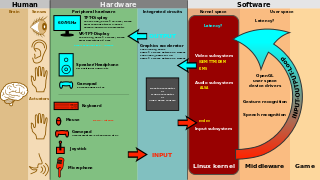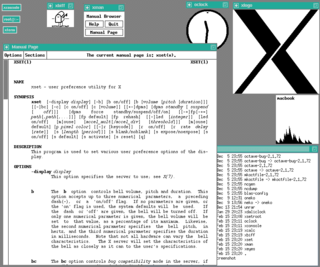Related Research Articles

In mathematics and computer science, an algorithm is a finite sequence of well-defined instructions, typically used to solve a class of specific problems or to perform a computation. Algorithms are used as specifications for performing calculations and data processing. By making use of Artificial Intelligence, algorithms can perform automated deductions and use mathematical and logical tests to divert the code through various routes. Using human characteristics as descriptors of machines in metaphorical ways was already practiced by Alan Turing with terms such as "memory", "search" and "stimulus".
Computer programming is the process of performing a particular computation, usually by designing/building an executable computer program. Programming involves tasks such as analysis, generating algorithms, profiling algorithms' accuracy and resource consumption, and the implementation of algorithms. The source code of a program is written in one or more languages that are intelligible to programmers, rather than machine code, which is directly executed by the central processing unit. The purpose of programming is to find a sequence of instructions that will automate the performance of a task on a computer, often for solving a given problem. Proficient programming thus usually requires expertise in several different subjects, including knowledge of the application domain, specialized algorithms, and formal logic.
In computing, a compiler is a computer program that translates computer code written in one programming language into another language. The name "compiler" is primarily used for programs that translate source code from a high-level programming language to a lower level language to create an executable program.
In imperative programming, a computer program is a sequence of instructions in a programming language that a computer can execute or interpret. In declarative programming, a computer program is a set of instructions.

In computer science, an interpreter is a computer program that directly executes instructions written in a programming or scripting language, without requiring them previously to have been compiled into a machine language program. An interpreter generally uses one of the following strategies for program execution:
- Parse the source code and perform its behavior directly;
- Translate source code into some efficient intermediate representation or object code and immediately execute that;
- Explicitly execute stored precompiled bytecode made by a compiler and matched with the interpreter Virtual Machine.
Computer science is the study of the theoretical foundations of information and computation and their implementation and application in computer systems. One well known subject classification system for computer science is the ACM Computing Classification System devised by the Association for Computing Machinery.

Automation describes a wide range of technologies that reduce human intervention in processes. Human intervention is reduced by predetermining decision criteria, subprocess relationships, and related actions — and embodying those predeterminations in machines.
In computer science, runtime, run time, or execution time is the final phase of a computer program's life cycle, in which the code is being executed on the computer's central processing unit (CPU) as machine code. In other words, "runtime" is the running phase of a program.
An Internet bot, web robot, robot or simply bot, is a software application that runs automated tasks (scripts) over the Internet. An Internet bot plays the client role in a client-server model whereas the server role is usually played by web servers. Internet bots are able to perform tasks, that are simple and repetitive, much faster than a person could ever do. The most extensive use of bots is for web crawling, in which an automated script fetches, analyzes and files information from web servers. More than half of all web traffic is generated by bots.
In computer science, data validation is the process of ensuring data has undergone data cleansing to ensure they have data quality, that is, that they are both correct and useful. It uses routines, often called "validation rules", "validation constraints", or "check routines", that check for correctness, meaningfulness, and security of data that are input to the system. The rules may be implemented through the automated facilities of a data dictionary, or by the inclusion of explicit application program validation logic of the computer and its application.

User interface (UI) design or user interface engineering is the design of user interfaces for machines and software, such as computers, home appliances, mobile devices, and other electronic devices, with the focus on maximizing usability and the user experience. In computer or software design, user interface (UI) design is the process of building interfaces that are aesthetically pleasing. Designers aim to build interfaces that are easy and pleasant to use. UI design refers to graphical user interfaces and other forms of interface design. The goal of user interface design is to make the user's interaction as simple and efficient as possible, in terms of accomplishing user goals.

In computing, a shell is a computer program which exposes an operating system's services to a human user or other programs. In general, operating system shells use either a command-line interface (CLI) or graphical user interface (GUI), depending on a computer's role and particular operation. It is named a shell because it is the outermost layer around the operating system.
Amazon Mechanical Turk (MTurk) is a crowdsourcing website for businesses to hire remotely located "crowdworkers" to perform discrete on-demand tasks that computers are currently unable to do. It is operated under Amazon Web Services, and is owned by Amazon. Employers post jobs known as Human Intelligence Tasks (HITs), such as identifying specific content in an image or video, writing product descriptions, or answering questions, among others. Workers, colloquially known as Turkers or crowdworkers, browse among existing jobs and complete them in exchange for a rate set by the employer. To place jobs, the requesting programs use an open application programming interface (API), or the more limited MTurk Requester site. As of April 2019, Requesters could register from only 49 approved countries.
Human-based computation (HBC), human-assisted computation, ubiquitous human computing or distributed thinking is a computer science technique in which a machine performs its function by outsourcing certain steps to humans, usually as microwork. This approach uses differences in abilities and alternative costs between humans and computer agents to achieve symbiotic human–computer interaction. For computationally difficult tasks such as image recognition, human-based computation plays a central role in training Deep Learning-based Artificial Intelligence systems. In this case, human-based computation has been referred to as human-aided artificial intelligence.

Crowdsourcing is a sourcing model in which individuals or organizations obtain goods or services—including ideas, voting, micro-tasks, and finances—from a large, relatively open, and often rapidly evolving group of participants.

A computer is a digital electronic machine that can be programmed to carry out sequences of arithmetic or logical operations (computation) automatically. Modern computers can perform generic sets of operations known as programs. These programs enable computers to perform a wide range of tasks. A computer system is a "complete" computer that includes the hardware, operating system, and peripheral equipment needed and used for "full" operation. This term may also refer to a group of computers that are linked and function together, such as a computer network or computer cluster.
In computability theory, the halting problem is the problem of determining, from a description of an arbitrary computer program and an input, whether the program will finish running, or continue to run forever. Alan Turing proved in 1936 that a general algorithm to solve the halting problem for all possible program-input pairs cannot exist.
Microwork is a series of many small tasks which together comprise a large unified project, and it is completed by many people over the Internet. Microwork is considered the smallest unit of work in a virtual assembly line. It is most often used to describe tasks for which no efficient algorithm has been devised, and require human intelligence to complete reliably. The term was developed in 2008 by Leila Chirayath Janah of Samasource.
This glossary of artificial intelligence is a list of definitions of terms and concepts relevant to the study of artificial intelligence, its sub-disciplines, and related fields. Related glossaries include Glossary of computer science, Glossary of robotics, and Glossary of machine vision.
This glossary of computer science is a list of definitions of terms and concepts used in computer science, its sub-disciplines, and related fields, including terms relevant to software, data science, and computer programming.
References
- ↑ "Web Archive - Mechanical Turk Welcome page". Archived from the original on 5 November 2005.
- ↑ "CHI, a Collaborative Human Interpreter".